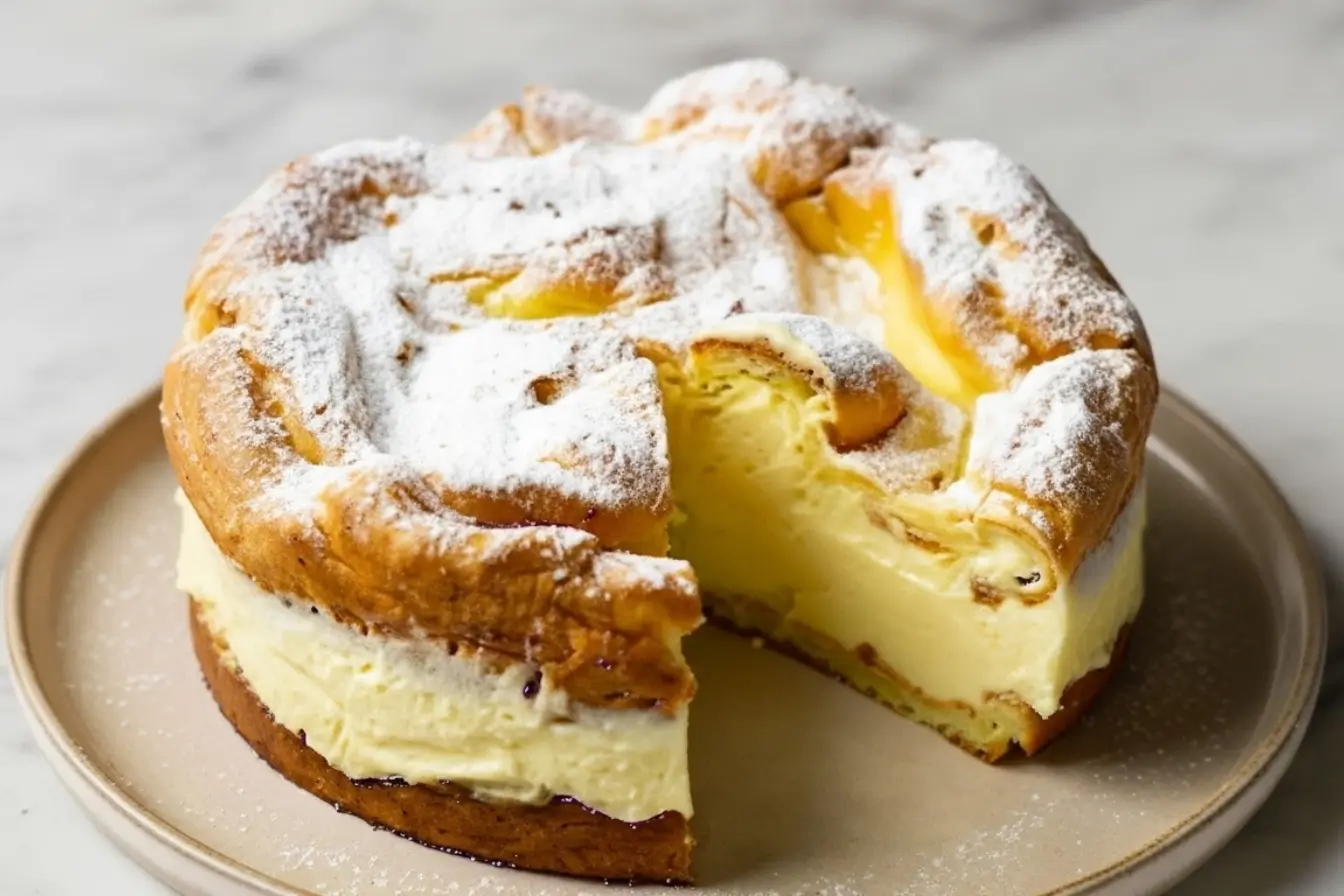This Karpatka (Polish Custard Cake) is a traditional dessert that will transport you straight to a cozy kitchen in Poland. Two layers of a light, mountain-like pastry hold a generous filling of rich and creamy vanilla custard. It’s a truly special cake, perfect for sharing with loved ones.
My sister Jennifer introduced me to this beautiful cake. I’ll always treasure the memory of our first time baking it together, laughing in a kitchen dusted with flour. She has a knack for finding these wonderful recipes, and this one, with its creamy vanilla filling, is pure joy.
What Makes This Polish Cake So Special?
- A Tale of Two Textures: The magic of this traditional Polish cake lies in the contrast between the light, crisp choux pastry and the rich, smooth vanilla custard filling.
- Mountain-Inspired Name: “Karpatka” gets its name from the Polish word for the Carpathian Mountains, Karpaty. The uneven, bumpy top of the pastry, once dusted with powdered sugar, resembles the snowy mountain peaks.
- Patience is Key: This isn’t a quick dessert, but the results are worth it. Allowing the pastry and custard to cool completely before assembly is crucial for the best texture and clean slices.
- Choux Pastry, Not Puff Pastry: While it may look like puff pastry, Karpatka is made with pâte à choux, the same dough used for cream puffs and eclairs, which is more approachable for home bakers.
- Temperature Matters: For the creamiest filling, ensure your cooked custard has cooled to room temperature and the butter is properly softened before beating them together.
What We’ll Need from the Pantry
For the Pastry Layers:
- 1 cup water
- ½ cup unsalted butter
- 1 cup all-purpose flour
- 4 large eggs
- ¼ teaspoon salt
For the Vanilla Custard Filling:
- 2 cups milk
- ½ cup granulated sugar
- 3 tablespoons cornstarch
- 2 tablespoons all-purpose flour
- 4 large egg yolks
- ½ cup unsalted butter, softened
- 1 teaspoon vanilla extract
For Dusting:
- Powdered sugar, for serving
A Few Helpful Tools from My Kitchen
Electric Mixer
An electric mixer really is a lifesaver here; it makes whipping the butter and custard into that perfectly light and airy cream an absolute breeze.
A Good Whisk
A reliable whisk is your best friend when making the custard, it’s the key to keeping everything silky smooth and free of lumps.
Our Step-by-Step Journey to Karpatka
Whipping Up the Mountain Pastry
Preheat your oven to 400°F (200°C). Go ahead and line two 9-inch round pans with parchment paper. In a saucepan, bring the water, butter, and salt to a rolling boil. Turn the heat down and add all the flour at once. The secret here is to stir with a wooden spoon like you mean it, until the dough forms a ball and pulls away from the sides of the pan. Take it off the heat and let it cool for just about 5 minutes, you don’t want to scramble the eggs!
Baking the Golden Peaks
Now, add the eggs one at a time. It’s important to beat each egg in completely before adding the next. Your arm might get a little tired, but keep going until the dough is smooth and glossy. Divide this lovely dough between your two prepared pans, spreading it as evenly as you can. Don’t worry about making it perfectly smooth; those little bumps will become the famous “mountains.” Bake for 25-30 minutes until they are puffed up and a beautiful golden brown. Let them cool completely.
Starting the Silky Custard
While the pastry cools, let’s make that dreamy vanilla custard. Gently heat the milk in a saucepan until it’s just warm. In a separate bowl, whisk the sugar, cornstarch, flour, and egg yolks together until they’re pale and combined. Now, slowly, very slowly, pour the warm milk into the egg mixture while whisking constantly. This tempers the eggs and prevents them from curdling.
The Secret to a Perfect Cream
Pour the entire mixture back into the saucepan. Cook it over medium heat, whisking all the while, until it becomes wonderfully thick and smooth. This should take about 5 minutes. Remove it from the heat and stir in the vanilla extract. To prevent a skin from forming, you can press a piece of plastic wrap directly onto the surface of the custard. Now, the hard part: let it cool all the way down to room temperature.
Finishing Our Dreamy Filling
Once the custard is completely cool, it’s time for the final touch. Beat the softened butter until it’s light and creamy. Then, gradually add the cooled custard a spoonful at a time, beating continuously until the filling is perfectly smooth and airy.
The Grand Finale: Assembling Our Cake
It’s time to build your masterpiece! Place one of the cooled pastry layers on your favorite serving plate. Spoon the vanilla cream filling over it, spreading it in a thick, even layer. Top with the second pastry layer, pressing down gently. Pop the cake in the refrigerator for at least 2 hours to allow the custard to set firmly.
A Snowy Dusting to Finish
Just before serving, give your Karpatka a generous dusting of powdered sugar. It looks just like freshly fallen snow! Slice it up and serve it chilled. It’s absolutely perfect with a warm cup of coffee or tea.

A Quick Note on Nutrition
Please note that the nutritional values provided are an estimate and can vary based on the specific ingredients and brands you use. This information is intended as a general guide.
For a Lighter Touch
- Sugar Substitute: For a lower-sugar version, you can replace the granulated sugar in the custard with a cup-for-cup sugar substitute suitable for baking.
- Milk Choice: While whole milk provides the richest flavor, you can use low-fat milk for the custard to reduce the fat content.
- Fruit Sweetness: Reduce the sugar in the filling and serve the cake with a side of fresh berries or a simple fruit compote for natural sweetness.
How We Love to Serve This Cake
- With a Berry Drizzle: A simple raspberry or strawberry sauce drizzled over each slice adds a lovely tartness that cuts through the richness of the cream.
- A Touch of Chocolate: For a more decadent dessert, lightly drizzle melted dark chocolate over the top before the final dusting of powdered sugar.
- Warm and Cozy: This traditional Polish dessert is perfectly paired with a hot beverage. Serve it with a freshly brewed pot of coffee or a fragrant cup of Earl Grey tea for a comforting treat.
A Few Tips from My Kitchen
- Lumpy Custard: This often happens if the milk is added too quickly to the eggs or if the custard isn’t whisked constantly while cooking. To fix minor lumps, you can strain the custard through a fine-mesh sieve before cooling. For more significant lumps, a quick blitz with an immersion blender can save it.
- Runny Filling: If the custard is too warm when you add the butter, the butter will melt and the filling won’t set properly. It is essential that both the custard and the softened butter are at a similar room temperature before combining them.
- Deflated Pastry: The choux pastry needs a hot oven to create steam and puff up. Avoid opening the oven door while the pastry is baking, as the sudden drop in temperature can cause it to collapse. Also, ensure the pastry is fully baked and golden before removing it.
Keeping Your Cake Fresh
This cake is best stored in an airtight container in the refrigerator. It will keep for up to 3 days, although the pastry will soften slightly over time. For the best texture, I recommend enjoying it within the first day or two. Unfortunately, this cake does not freeze well, as the custard’s texture will change upon thawing.
From My Kitchen to Yours
This Karpatka cake is more than just a dessert; it’s a celebration in itself. It’s the perfect centerpiece for a special occasion or simply for a quiet afternoon with family. I hope that when you bake this recipe, it fills your home with warmth and helps you create your own sweet memories.
A Few Questions You Might Have
What does “Karpatka” mean?
“Karpatka” gets its name from the Karpaty, the Polish name for the Carpathian Mountains. The craggy, uneven surface of the top pastry layer, especially when dusted with powdered sugar, is meant to resemble the snow-covered peaks of the mountain range.
Can I prepare this Karpatka cake ahead of time?
Yes, you can prepare the components in advance. The baked and completely cooled pastry layers can be stored in an airtight container at room temperature for a day. The custard can also be made a day ahead and kept in the refrigerator with plastic wrap pressed against the surface. When you’re ready, bring the custard to room temperature, whip the butter, and assemble the cake as directed.
Why didn’t my choux pastry layers puff up?
There are a few common reasons for flat pastry. First, the liquid, butter, and salt mixture might not have come to a full boil before adding the flour. Second, the dough may not have been cooked long enough on the stove to dry out sufficiently. Lastly, opening the oven door mid-bake can cause the pastry to deflate.
Print
Karpatka (Polish Custard Cake)
- Total Time: 2 hours 30 minutes
- Yield: 10 servings 1x
- Diet: Vegetarian
Description
A traditional Polish dessert with two layers of light choux pastry and a rich, creamy vanilla custard filling that resembles snowy mountain peaks.
Ingredients
- 1 cup water
- 1/2 cup unsalted butter
- 1 cup all-purpose flour
- 4 large eggs
- 1/4 teaspoon salt
- 2 cups milk
- 1/2 cup granulated sugar
- 3 tablespoons cornstarch
- 2 tablespoons all-purpose flour
- 4 large egg yolks
- 1/2 cup unsalted butter, softened
- 1 teaspoon vanilla extract
- Powdered sugar, for serving
Instructions
- Preheat oven to 400°F (200°C). Line two 9-inch round pans with parchment paper.
- In a saucepan, bring water, butter, and salt to a boil. Reduce heat, add flour all at once, and stir until dough forms a ball. Let cool for 5 minutes.
- Add eggs one at a time, beating well after each addition until dough is smooth and glossy.
- Divide dough between pans and spread evenly. Bake 25–30 minutes until puffed and golden. Cool completely.
- For the custard, warm milk in a saucepan. In a bowl, whisk sugar, cornstarch, flour, and egg yolks. Slowly whisk in warm milk to temper the eggs.
- Return mixture to saucepan and cook over medium heat, whisking constantly, until thick and smooth. Remove from heat and stir in vanilla. Cool completely with plastic wrap on the surface.
- Beat softened butter until light and creamy, then gradually add cooled custard, one spoonful at a time, until smooth.
- Place one pastry layer on a serving plate. Spread custard evenly, top with second layer, and refrigerate 2 hours.
- Dust generously with powdered sugar before serving.
Notes
For best texture, allow both pastry and custard to cool completely before assembly. Store in the refrigerator up to 3 days; not suitable for freezing.
- Prep Time: 30 minutes
- Cook Time: 30 minutes
- Category: Dessert
- Method: Baked
- Cuisine: Polish
Nutrition
- Serving Size: 1 slice
- Calories: 420
- Sugar: 20g
- Sodium: 160mg
- Fat: 26g
- Saturated Fat: 15g
- Unsaturated Fat: 10g
- Trans Fat: 0g
- Carbohydrates: 38g
- Fiber: 0g
- Protein: 7g
- Cholesterol: 190mg
Keywords: Karpatka, Polish Custard Cake, choux pastry, vanilla cream, traditional dessert

